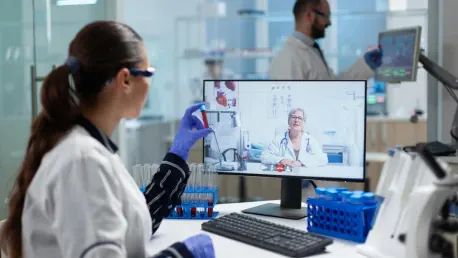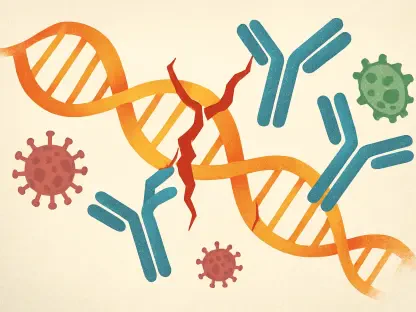The ongoing battle against COVID-19 has spurred a wave of innovative research, with scientists striving to develop effective treatments and preventive measures. A groundbreaking study by researchers at Stanford University and the Chan Zuckerberg Biohub introduces a novel framework called the “Virtual Lab.” This platform leverages the combined strengths of artificial intelligence (AI) and human expertise to design innovative nanobodies targeting evolving SARS-CoV-2 variants. Detailed in a preprint on the bioRxiv preprint server, this study highlights the potential of AI-human collaboration in accelerating scientific discovery. The Virtual Lab presents an unprecedented method of uniting sophisticated computational capabilities with the creativity and intuition of human scientists, thus paving the way for more rapid breakthroughs in ongoing healthcare challenges.
The Virtual Lab: A New Paradigm in Scientific Research
The Virtual Lab represents a significant shift in how scientific research is conducted, particularly in under-resourced environments. By integrating large language models (LLMs) and domain-specific AI agents with human expertise, the Virtual Lab aims to tackle complex interdisciplinary problems more efficiently. This collaborative platform is designed to streamline and enhance the scientific discovery process, reducing the reliance on extensive human input for sophisticated tasks. AI models alone have limitations in reasoning and creativity, which is where the synergy with human experts becomes invaluable. The study underscores the importance of this partnership in driving forward innovative solutions and maintaining a high level of adaptability in research processes.
The structure of the Virtual Lab includes a Principal Investigator (PI) agent who oversees the direction and coordinates the efforts of other AI agents and human researchers. This architecture promotes both team and individual meetings, where broad research topics are discussed collectively, and specialized tasks are handled individually. Each agent has defined roles and expertise in their respective fields, facilitating a structured and rigorous approach to interdisciplinary collaboration. The capability to handle expansive datasets, perform complex calculations, and iterate processes swiftly sets the Virtual Lab apart, ensuring that every phase of research benefits from the strengths of both AI and human intervention.
Designing Nanobodies Against SARS-CoV-2 Variants
A key focus of the study is the development and application of the Virtual Lab to design potent nanobodies against SARS-CoV-2. The researchers employed computational methods and iterative refinement processes to improve the binding efficacy of nanobody candidates toward specific variants of the virus. The Virtual Lab successfully designed 92 new nanobodies, of which two showed improved binding to recent SARS-CoV-2 variants, specifically JN.1 and KP.3. This achievement is notable, considering the continually evolving nature of the virus and the necessity for adaptable therapeutic strategies. The study’s approach of combining AI-driven analysis with human expertise exemplifies a balanced methodology for addressing complex biomedical challenges.
The approach encompassed several agent collaboration rounds, leveraging computational tools such as ESM (Evolutionary Scale Modeling), AlphaFold-Multimer, and Rosetta. These tools were used to optimize nanobody sequences through processes like log-likelihood analysis, structural prediction, and binding energy calculations. This systematic, iterative process involved continuous refinement of the nanobody sequences by introducing mutations and analyzing their impact using predefined scoring metrics, ultimately leading to sequences with enhanced binding affinity and structural stability. The power of AI in handling repetitive tasks without diminishing accuracy plays a critical role in this refinement process, ensuring rapid yet precise advancements in nanobody design.
Experimental Validation and Promising Results
The experimental validation of the 92 selected nanobodies showed successful expression in E. coli for 38% of the mutants, with 85% displaying improved binding to the Wuhan receptor-binding domain (RBD) protein. Two mutants, in particular, noted for their effective binding to additional variants like JN.1 and KP.3, showcased specific mutations (R37Q and L59E) resulting in enhanced electrostatic interactions and hydrogen bonding. This discovery underscores not only the efficiency of the Virtual Lab in generating viable nanobodies but also its potential in producing variant-specific treatments, a crucial requirement in the ongoing efforts to manage COVID-19.
This success, achieved with minimal human input and extensive AI agent collaboration, underscores the power of the Virtual Lab in driving rapid and robust scientific discovery. The collaborative AI and human effort significantly advances the process of complex projects, such as nanobody design for SARS-CoV-2 variants, demonstrating that sophisticated AI models can markedly enhance interdisciplinary research productivity. The combined strengths allow for a more detailed and efficient exploration of biological variants while maintaining high precision crucial for experimental success. The promising initial results furnish a strong foundation for further research and refinement.
Addressing Challenges and Future Prospects
While the study acknowledges constraints such as outdated LLM training data and imperfect tools, it emphasizes the evolving nature of LLMs and anticipates further improvements in interdisciplinary research effectiveness over time. This progressive evolution promises potential applications beyond biological research, harnessing the power of AI to revolutionize various scientific domains. As AI tools undergo continuous refinement and updates, the efficiency and accuracy of platforms like the Virtual Lab will likely see significant enhancements, making them indispensable assets in a wide array of scientific disciplines. The data-driven nature of AI ensures that with newer iterations, research can become more predictive and insightful.
The overarching trend in this research reflects a shift towards leveraging AI to mitigate the challenges of coordinating large, diverse teams in interdisciplinary sciences. Current AI frameworks, like ChemCrow and Coscientist, which focus on chemistry and synthesis planning, or AI Scientist, which applies to narrow machine learning applications, often lack real-world validation and do not effectively address multi-step reasoning across fields. The Virtual Lab, on the other hand, stands out by offering a more integrative solution with tangible experimental validation, meeting the critical needs of under-resourced research teams and interdisciplinary scientific discovery. The natural progression will see more collaborative efforts employing such integrative solutions to drive substantial advancements in global scientific challenges.
The Future of AI-Human Collaboration in Scientific Research
The study centers on developing and applying the Virtual Lab to design effective nanobodies against SARS-CoV-2. Researchers used computational methods and iterative refinement to enhance the binding efficacy of nanobody candidates against specific variants of the virus. The Virtual Lab produced 92 new nanobodies, with two showing improved binding to recent SARS-CoV-2 variants, JN.1 and KP.3. This is significant given the constantly evolving virus and the need for adaptable therapeutic strategies. The study’s approach of merging AI-driven analysis with human expertise illustrates a balanced method for tackling complex biomedical challenges.
The process involved several rounds of agent collaboration, utilizing computational tools like Evolutionary Scale Modeling (ESM), AlphaFold-Multimer, and Rosetta. These tools optimized nanobody sequences through log-likelihood analysis, structural prediction, and binding energy calculations. The iterative process included continuous refinement of nanobody sequences by introducing mutations and analyzing their effects using predefined scoring metrics. AI’s ability to handle repetitive tasks without losing accuracy is vital, ensuring rapid and precise advancements in nanobody design.









